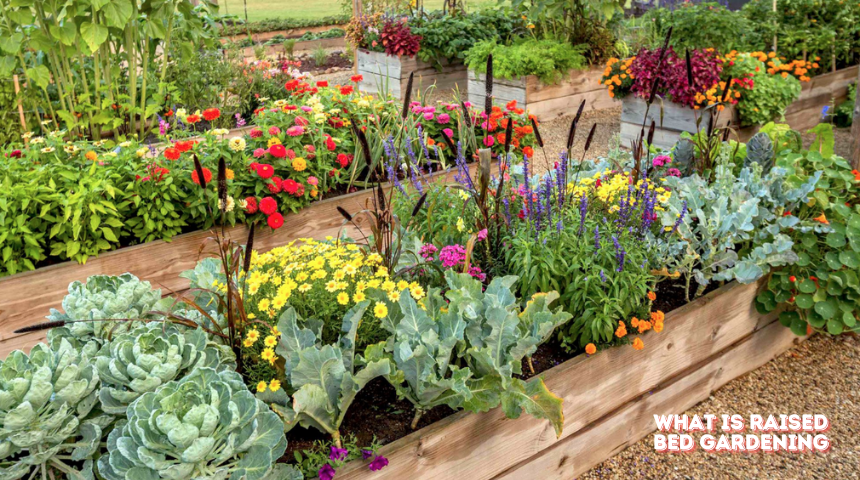What is Raised Bed Gardening. It’s a method where plants grow in elevated soil beds. This technique offers better control over soil quality. I started using raised beds a few years ago.
The benefits became clear almost instantly. Better drainage, fewer weeds, and easy access make it an ideal choice. Raised bed gardening is also great for small spaces.
The soil warms up faster in spring. This extends the growing season. Plus, it prevents soil compaction. I can manage plants easily without bending over too much. Healthier plants and higher yields are the result.
What Is Raised Bed Gardening?
Raised bed gardening is a method I use where soil is raised above ground level. The soil sits in a framed structure, usually made of wood, stone, or metal.
This allows better control over soil conditions. I can easily manage drainage, soil type, and nutrients. The raised beds help keep pests away and reduce weeds.
It also improves air circulation. I like how the soil warms up faster, which extends the growing season. Raised beds make gardening more accessible.
I don’t have to bend over as much, which makes it easier on the back. Healthier plants and better yields are often the result.
Why Choose A Raised Bed For Gardening? (Benefits)

There are many reasons I prefer raised beds for gardening.
First, better soil control is a key benefit. I can choose the perfect mix for my plants, ensuring optimal growth.
Second, raised beds improve drainage, which is essential for preventing root rot in wet conditions.
Third, they help me keep pests like slugs and snails at bay by lifting plants off the ground.
Fourth, I notice fewer weeds growing in my raised beds, making upkeep easier.
Lastly, raised beds are ergonomically friendly, reducing the need for bending and making gardening more enjoyable.
What Depth Is Ideal For A Raised Garden Bed?
The depth of a raised garden bed is crucial for plant health. I recommend a minimum depth of 12 inches. This depth gives plants enough room to grow their roots while ensuring the soil stays loose and well-drained.
For deeper-rooted vegetables like tomatoes or carrots, I opt for beds that are 18 to 24 inches deep. In my experience, the extra depth allows for better root growth and more vigorous plants.
If you’re growing shallow-rooted plants like lettuce, you can go with a shallower bed, but deeper beds are always more versatile.
What Materials Should Go At The Bottom Of A Raised Bed?

What goes at the bottom of a raised bed depends on the type of soil I’m working with. I typically start with a layer of organic matter, such as straw, leaves, or grass clippings.
This helps with drainage and adds nutrients to the soil as it breaks down. On top of that, I like to add a layer of cardboard or newspaper to suppress weeds.
Some gardeners add rocks or gravel for drainage, but I find this unnecessary for most situations. Instead, I focus on organic materials that improve soil health and prevent compaction over time.
Is It Necessary To Line A Raised Bed?
Lining a raised bed depends on the soil type and potential pests. I usually line my beds with landscape fabric to prevent weeds from growing up through the soil.
It also helps protect the bed from pests like moles or gophers. If I’m building a raised bed on poor or contaminated soil, lining it with a thicker material is essential to prevent the roots from reaching the bad soil.
However, in some cases, I skip the lining if the natural soil beneath the bed is healthy and free of pests.
Do I Need To Remove Grass Before Installing A Raised Bed?

I always remove grass before setting up a raised bed. Leaving grass underneath can lead to competition for nutrients and water with your plants.
If I don’t remove the grass, it may try to grow up through the soil and become a problem later on. I use a shovel or sod cutter to dig out the grass, making sure to remove any roots that could sprout again.
For an added layer of protection, I also place a layer of cardboard or newspaper on the bottom to smother any remaining grass or weeds.
How Should I Fill A Raised Bed?
Filling a raised bed requires a balance of materials. I like to start with a layer of organic matter at the bottom, such as leaves, straw, or compost. This base layer helps with drainage and provides nutrients as it breaks down.
Then, I add a high-quality garden soil mix that’s rich in organic matter. I typically aim for a blend of topsoil, compost, and aged manure.
The final layer is a fine mulch to keep the soil moist and suppress weeds. I avoid filling my raised beds with pure compost or sand, as these materials can affect drainage and plant growth.
What Dimensions Work Best For A Raised Bed?
I find that raised beds work best when they are 4 feet wide and about 8 feet long. The 4-foot width allows me to easily reach the middle of the bed from either side without stepping on the soil, which helps prevent compaction.

The length of the bed depends on the available space, but I usually keep it to 8 feet for convenience. If space is limited, I’ll adjust the length but keep the width the same.
The height of the bed is also important. I recommend a height of 12 to 18 inches for most plants, but for those who prefer not to bend over, a higher bed can be even more comfortable.
What’s The Optimal Placement For Raised Garden Beds?
When I set up a raised bed, sun exposure is my top priority. Most vegetables and flowers need at least 6 to 8 hours of sunlight daily, so I place my beds in a sunny spot.
I also ensure that the bed is positioned for good air circulation to prevent fungal diseases. If possible, I avoid placing the bed near large trees or shrubs, as their roots can compete with the plants in the raised bed.
Finally, I make sure the bed is close to a water source. This saves time and effort during the growing season, especially in hot weather.
FAQ
Can I grow any type of plant in a raised bed?
Yes, most plants can thrive in a raised bed, including vegetables, flowers, and herbs. The key is to choose the right soil mix and depth based on the plant’s needs.
How often should I water a raised bed garden?
water my raised beds about 2 to 3 times a week, depending on the weather. Raised beds tend to drain faster, so they might need more frequent watering than in-ground gardens.
Can I use a raised bed for growing in cold climates?
Yes, raised beds are great for cold climates. The soil in raised beds warms up faster in the spring, which can extend your growing season.
How long do raised beds last?
The lifespan of a raised bed depends on the materials used. A well-built wooden bed can last 8 to 10 years or more, while metal and stone beds last longer.
Do I need special soil for a raised bed?
Yes, I recommend using a high-quality garden soil mix with plenty of organic matter. This ensures good drainage, root growth, and nutrient availability. Avoid using regular topsoil alone.
Conclusion
Raised bed gardening has made my gardening experience more enjoyable and productive. It gives me better control over soil quality, which helps my plants grow strong.
I love how the elevated beds improve drainage and reduce weed problems. Plus, it’s easier on my back since I don’t have to bend down as much.
I can experiment with different plants and see great results each season. The versatility of raised beds lets me adapt to small spaces or poor soil conditions.
It’s a simple method that brings healthier plants and higher yields. I highly recommend raised bed gardening to anyone who wants an easier and more efficient way to grow.



